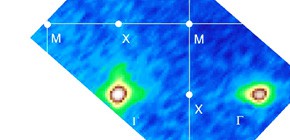
Clarification of the electronic structure of ultra-thin metal layers at the interface of two band insulating oxides
In cooperation with Professor Claessen and Dr. Sing , Julius-Maximilians-Universität Würzburg, Germany, and SAITO Yuji , Senior Research Fellow, Japan Atomic Energy Agency, and under the leadership of SUGA Shigemasa , Specially Appointed Professor, Institute of Scientific and Industrial Research, Osaka University, SEKIYAMA Akira , Professor, FUJIWARA Hideki , Assistant Professor, Graduate School of Engineering Science, and YAMASAKI Atsushi , Associate Professor, Konan University, a group of researchers succeeded for the first time in clarifying the electronic structure of ultra-thin metal layers at the interface of two band insulating oxides. To achieve this they used world-class soft X-ray angle-resolved photoelectron spectroscopy at BL23SU in the synchrotron radiation facility SPring-8 of the Japan Atomic Energy Agency. The two-dimensional conducting state is considered stable because of insulating oxides; however, by controlling the production method, interface superconductivity and interface magnetism can be induced. Using an advanced measuring method, this group clarified the electronic structure of new ultra-thin two dimensional conductive materials, anticipated in nano technology, but which have been hard to map.
Abstract
The interface between LaAlO3 and SrTiO3 hosts a two-dimensional electron system of itinerant carriers, although both oxides are band insulators. Interface ferromagnetism coexisting with superconductivity has been found and attributed to local moments. Experimentally, it has been established that Ti 3d electrons are confined to the interface. Using soft x-ray angle-resolved resonant photoelectron spectroscopy we have directly mapped the interface states in k-space. Our data demonstrate a charge dichotomy. A mobile fraction contributes to Fermi surface sheets, whereas a localized portion at higher binding energies is tentatively attributed to electrons trapped by Ovacancies in the SrTiO3. While photovoltage effects in the polar LaAlO3 layers cannot be excluded, the apparent absence of surface-related Fermi surface sheets could also be fully reconciled in a recently proposed electronic reconstruction picture where the built-in potential in the LaAlO3 is compensated by surface O-vacancies serving also as charge reservoir.

To learn more about this research, please read the full research report entitled " Direct k-Space Mapping of the Electronic Structure in an Oxide-Oxide Interface " at this page of the Physical Review Letters website.
Related link :

